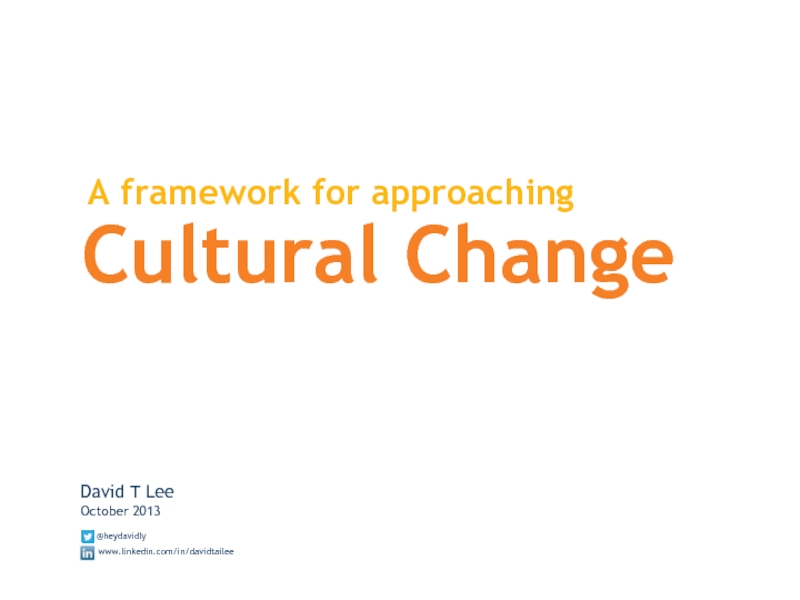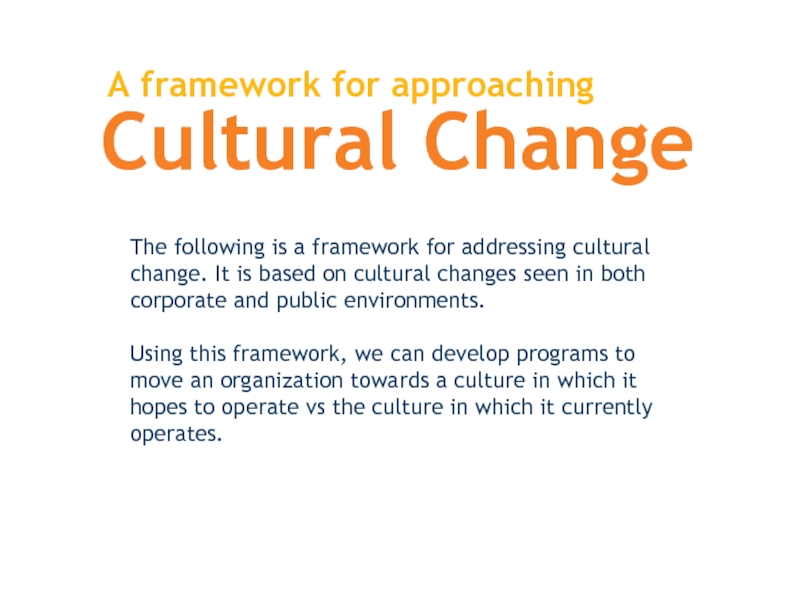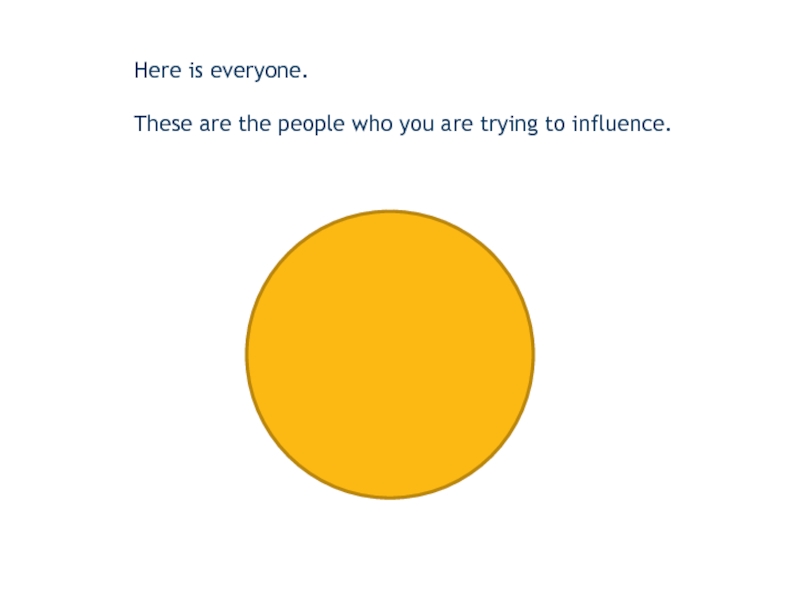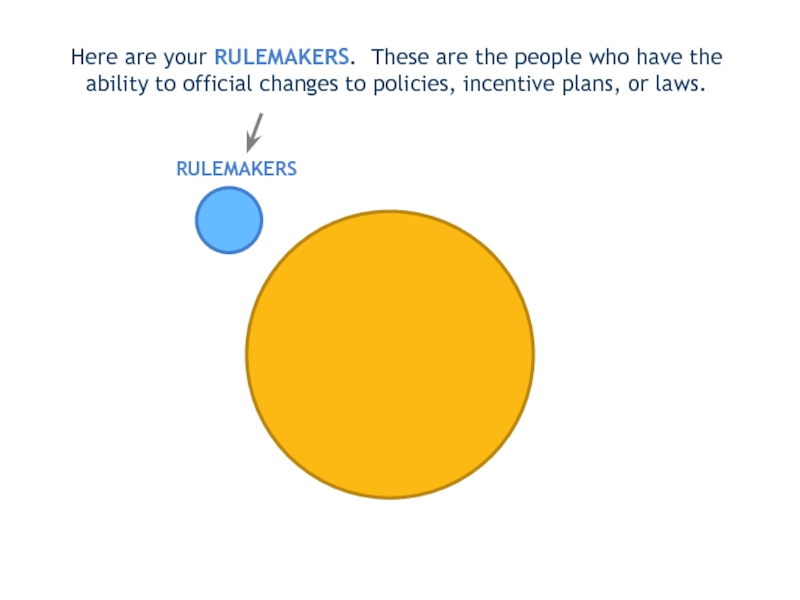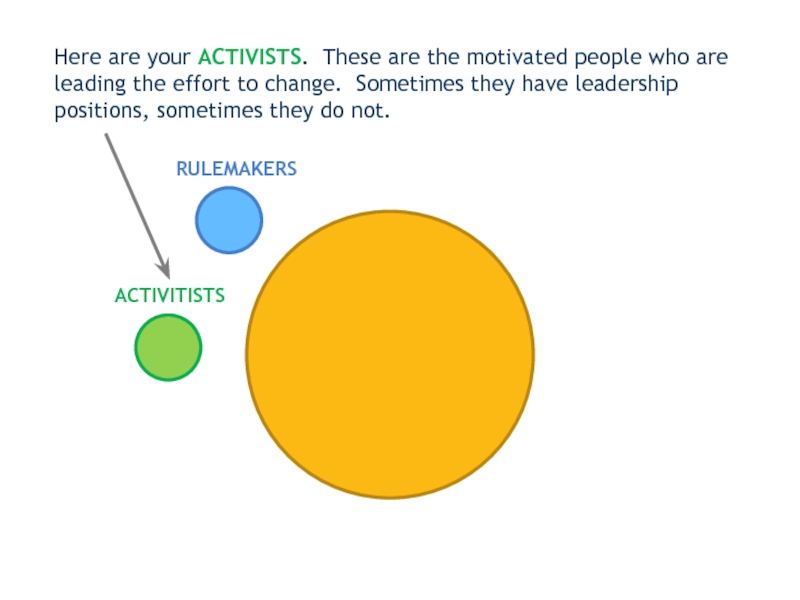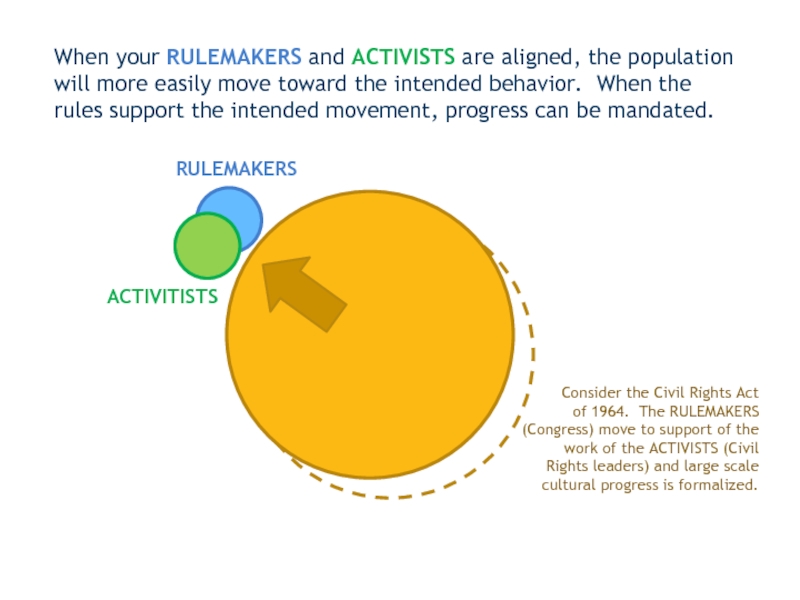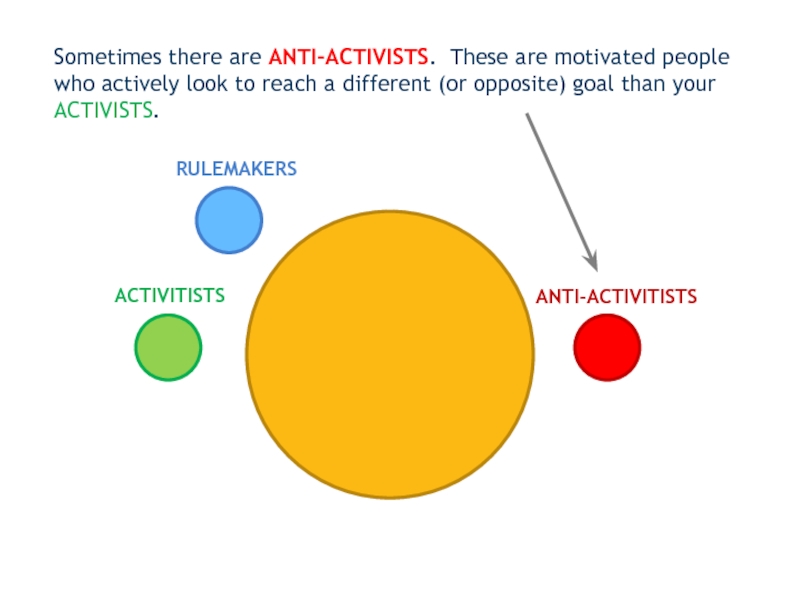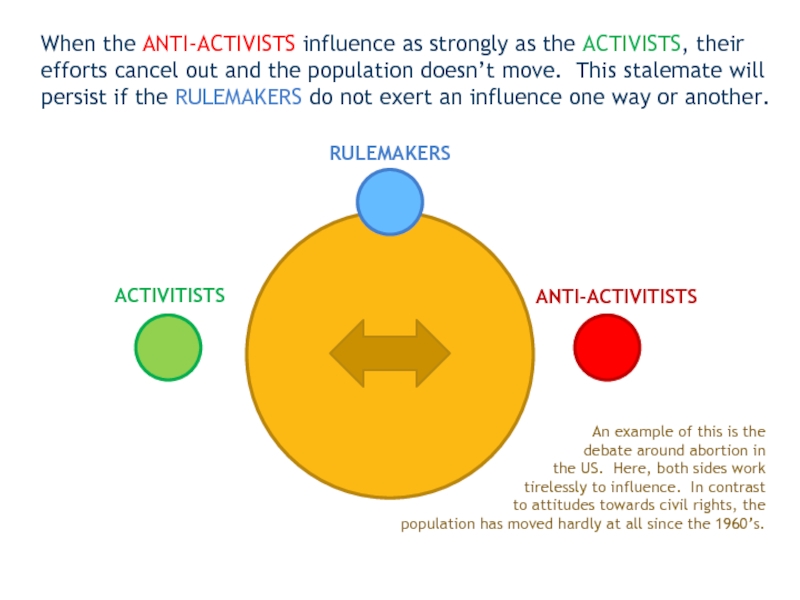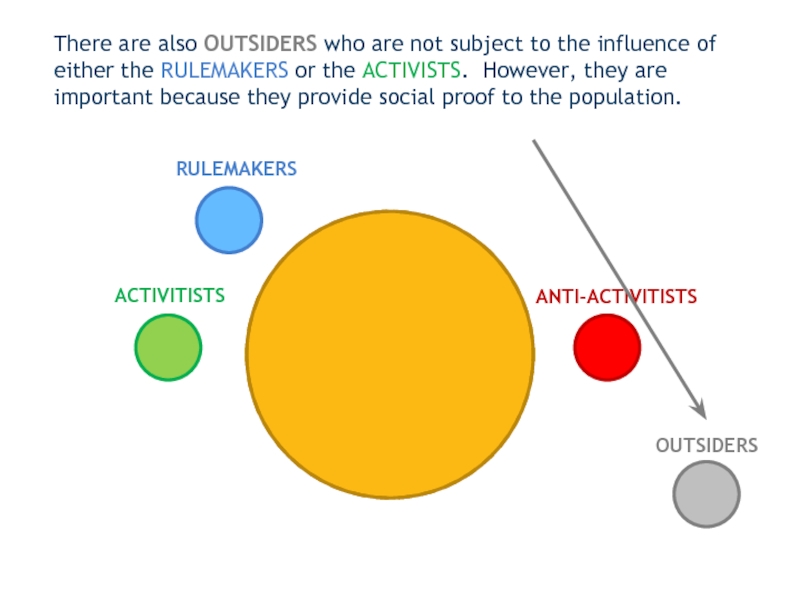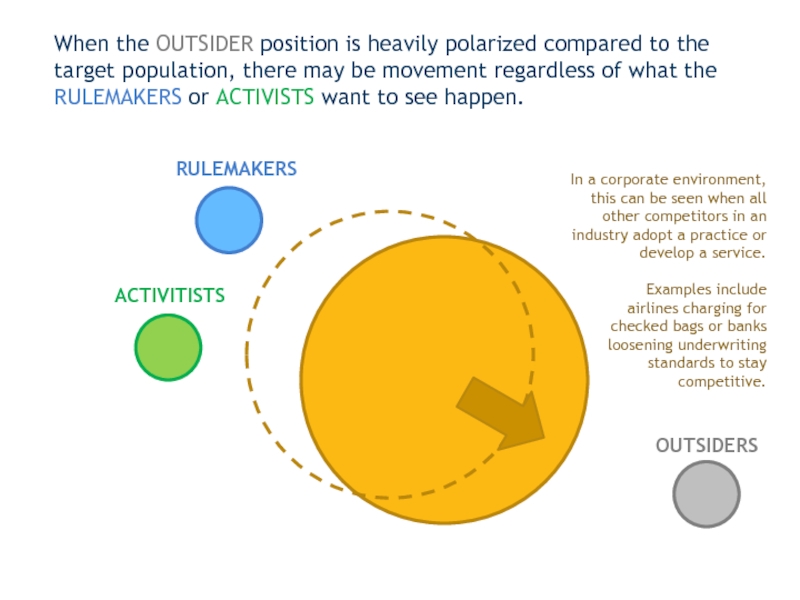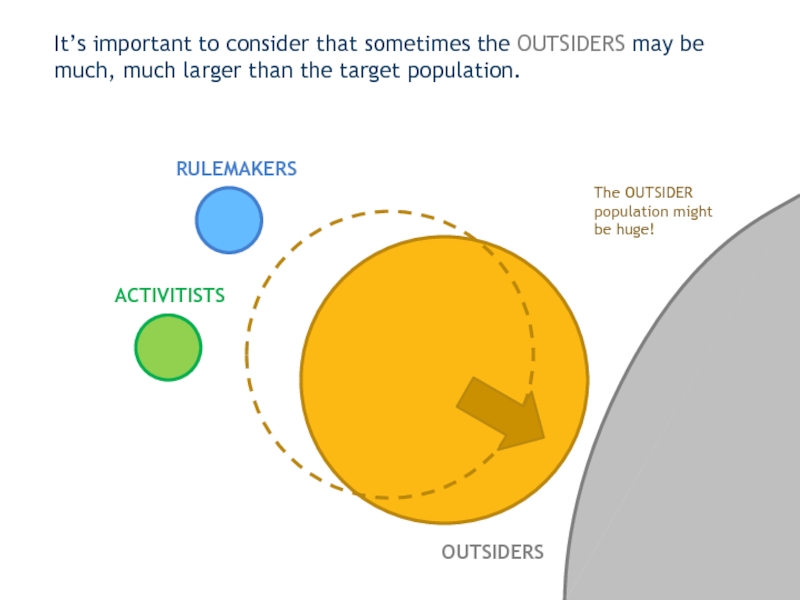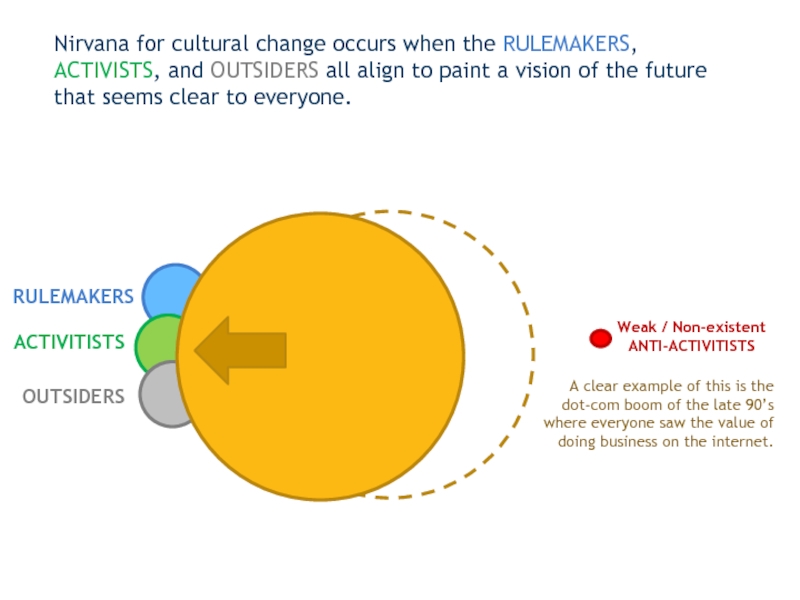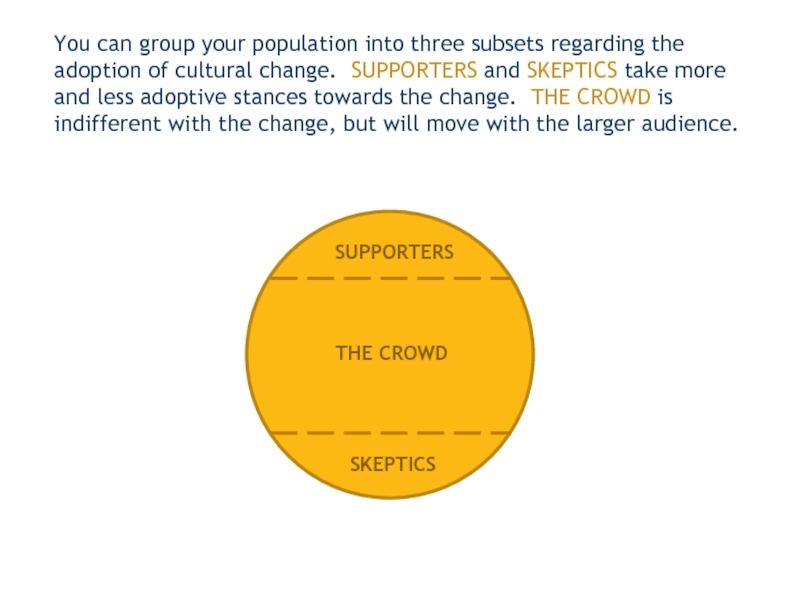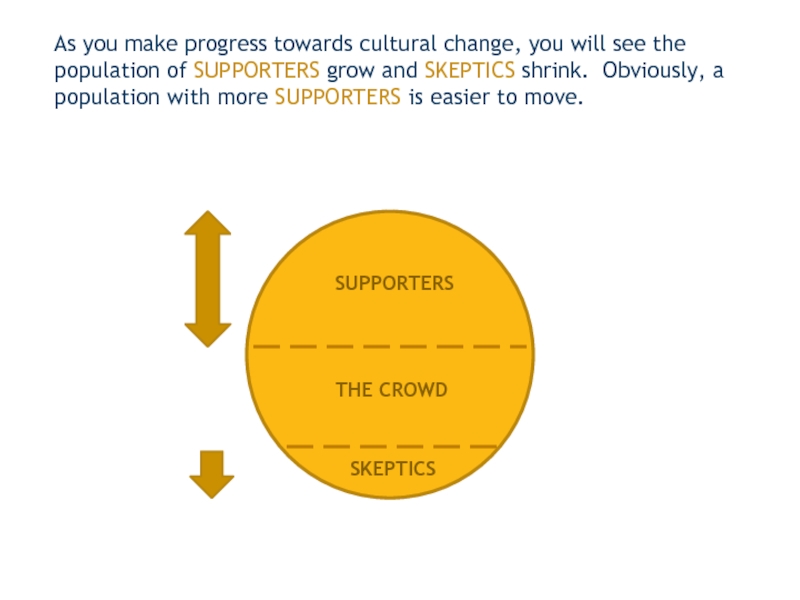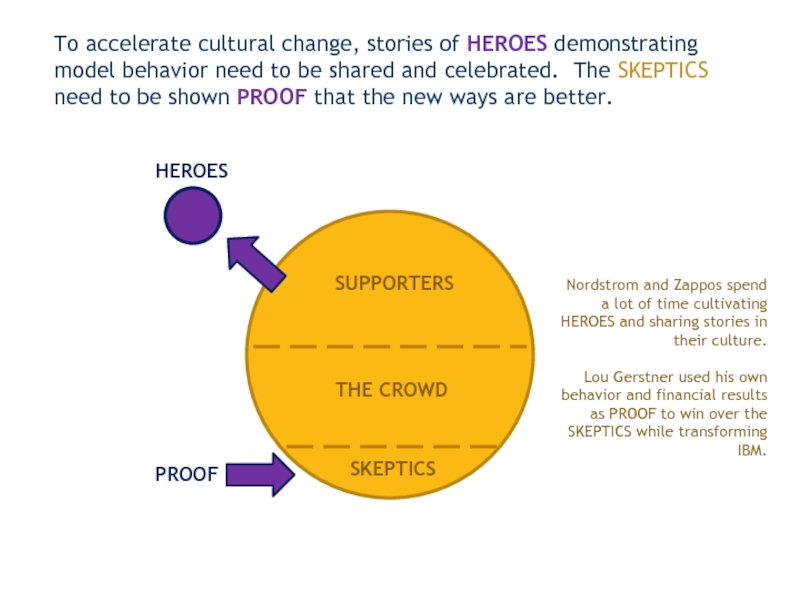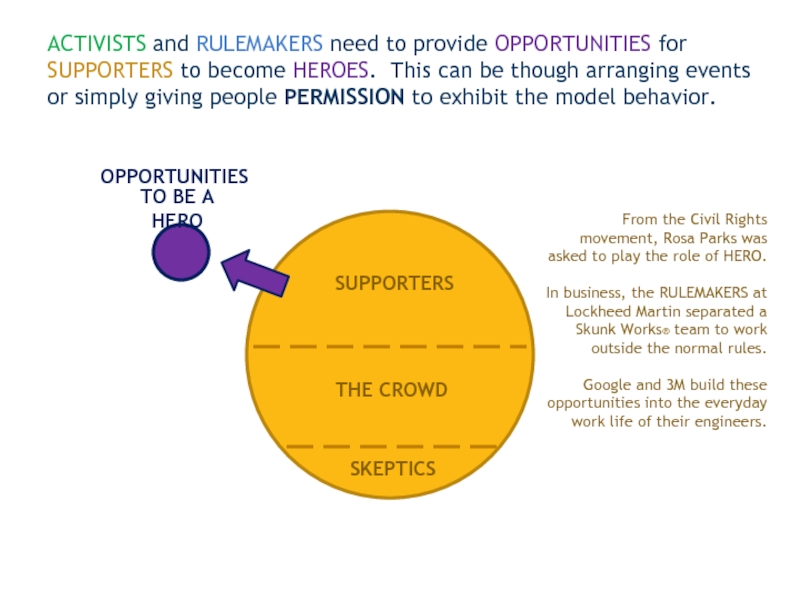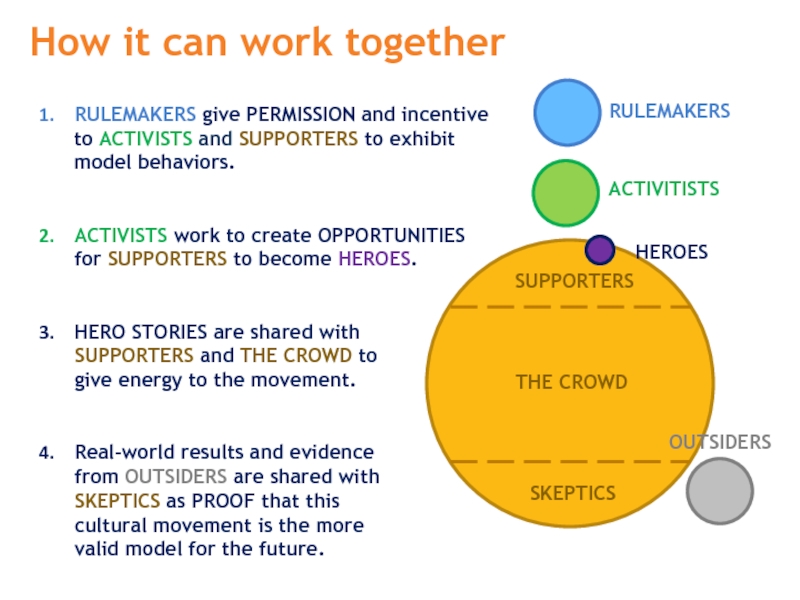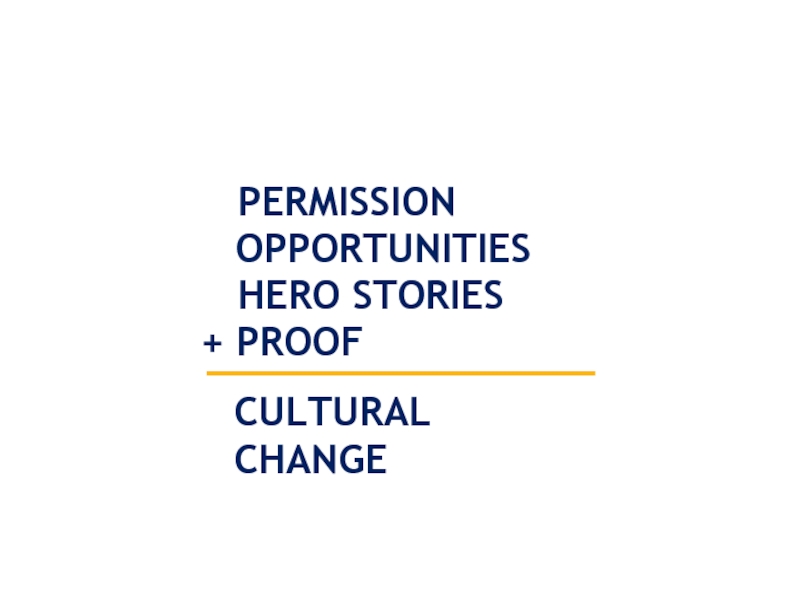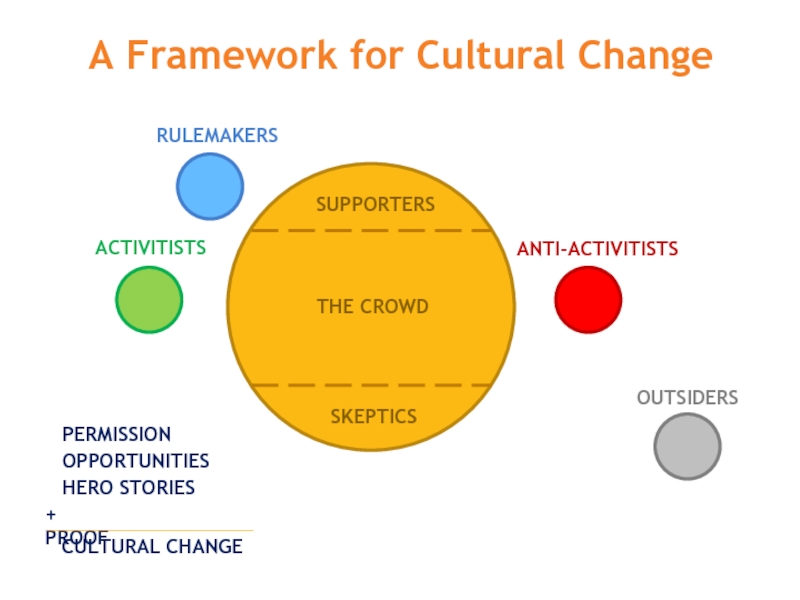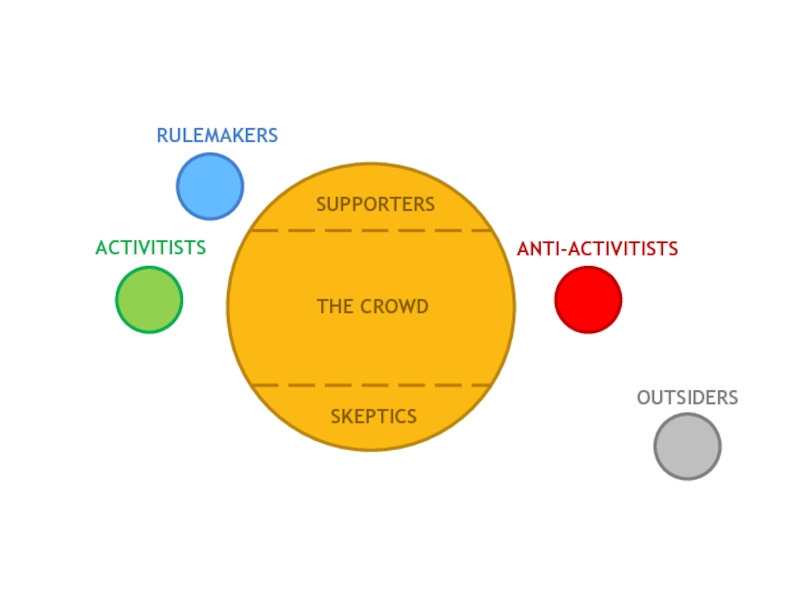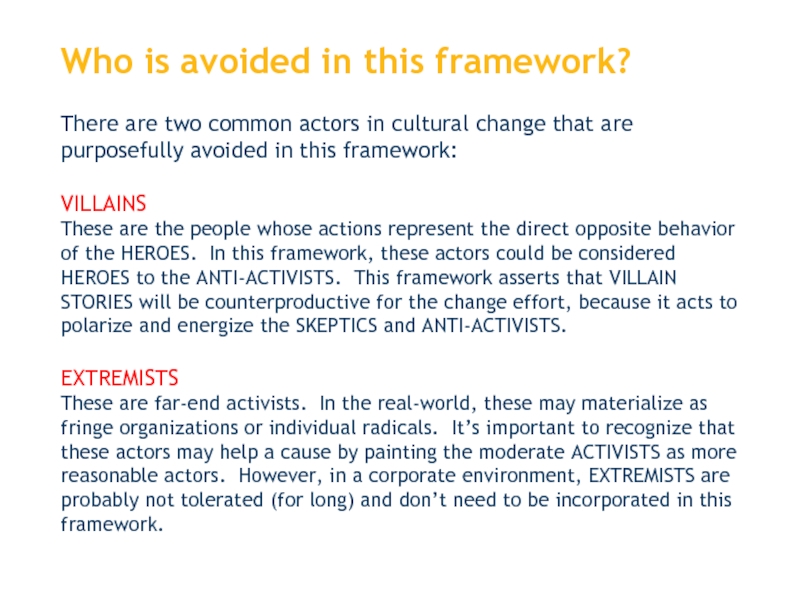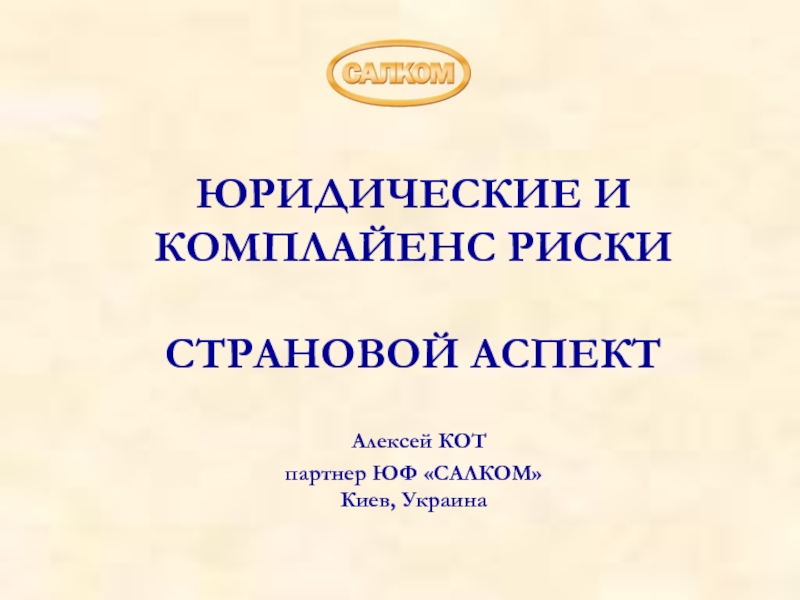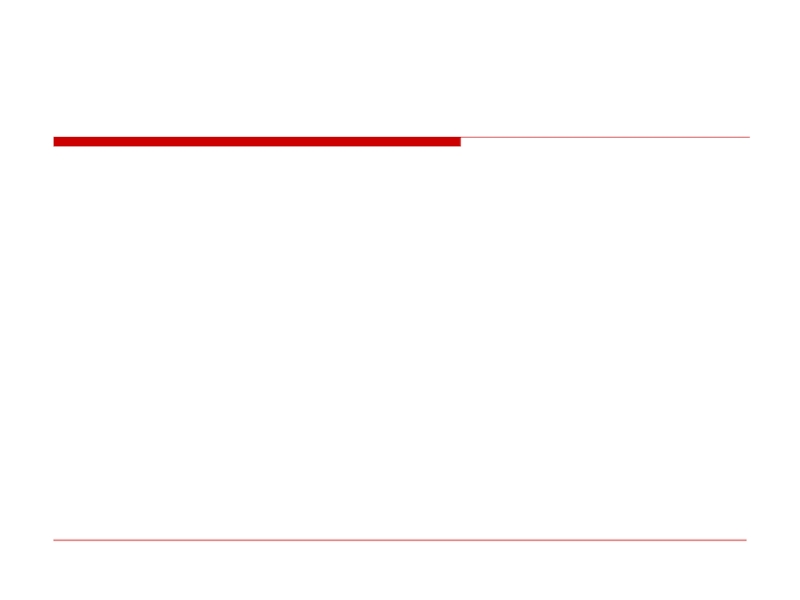- Главная
- Разное
- Дизайн
- Бизнес и предпринимательство
- Аналитика
- Образование
- Развлечения
- Красота и здоровье
- Финансы
- Государство
- Путешествия
- Спорт
- Недвижимость
- Армия
- Графика
- Культурология
- Еда и кулинария
- Лингвистика
- Английский язык
- Астрономия
- Алгебра
- Биология
- География
- Детские презентации
- Информатика
- История
- Литература
- Маркетинг
- Математика
- Медицина
- Менеджмент
- Музыка
- МХК
- Немецкий язык
- ОБЖ
- Обществознание
- Окружающий мир
- Педагогика
- Русский язык
- Технология
- Физика
- Философия
- Химия
- Шаблоны, картинки для презентаций
- Экология
- Экономика
- Юриспруденция
Cultural Change презентация
Содержание
- 1. Cultural Change
- 2. The following is a framework for addressing
- 3. Here is everyone. These are
- 4. Here are your RULEMAKERS. These are the
- 5. Here are your ACTIVISTS. These are the
- 6. When your RULEMAKERS and ACTIVISTS are aligned,
- 7. Sometimes there are ANTI-ACTIVISTS. These are motivated
- 8. When the ANTI-ACTIVISTS influence as strongly as
- 9. There are also OUTSIDERS who are not
- 10. When the OUTSIDER position is heavily polarized
- 11. It’s important to consider that sometimes
- 12. Nirvana for cultural change occurs when the
- 13. You can group your population into three
- 14. As you make progress towards cultural change,
- 15. To accelerate cultural change, stories of HEROES
- 16. ACTIVISTS and RULEMAKERS need to provide OPPORTUNITIES
- 17. RULEMAKERS ACTIVITISTS SUPPORTERS SKEPTICS
- 18. HERO STORIES + PROOF OPPORTUNITIES CULTURAL CHANGE PERMISSION
- 19. RULEMAKERS ACTIVITISTS ANTI-ACTIVITISTS
- 20. RULEMAKERS ACTIVITISTS ANTI-ACTIVITISTS OUTSIDERS SUPPORTERS SKEPTICS THE CROWD
- 21. There are two common actors in cultural
Слайд 1
A framework for approaching
Cultural Change
David T Lee
October 2013
@heydavidly
www.linkedin.com/in/davidtailee
Слайд 2The following is a framework for addressing cultural change. It is
Using this framework, we can develop programs to move an organization towards a culture in which it hopes to operate vs the culture in which it currently operates.
A framework for approaching
Cultural Change
Слайд 4Here are your RULEMAKERS. These are the people who have the
RULEMAKERS
Слайд 5Here are your ACTIVISTS. These are the motivated people who are
RULEMAKERS
ACTIVITISTS
Слайд 6When your RULEMAKERS and ACTIVISTS are aligned, the population will more
RULEMAKERS
ACTIVITISTS
Consider the Civil Rights Act
of 1964. The RULEMAKERS (Congress) move to support of the work of the ACTIVISTS (Civil Rights leaders) and large scale cultural progress is formalized.
Слайд 7Sometimes there are ANTI-ACTIVISTS. These are motivated people who actively look
RULEMAKERS
ACTIVITISTS
ANTI-ACTIVITISTS
Слайд 8When the ANTI-ACTIVISTS influence as strongly as the ACTIVISTS, their efforts
RULEMAKERS
ACTIVITISTS
ANTI-ACTIVITISTS
An example of this is the
debate around abortion in
the US. Here, both sides work
tirelessly to influence. In contrast
to attitudes towards civil rights, the
population has moved hardly at all since the 1960’s.
Слайд 9There are also OUTSIDERS who are not subject to the influence
RULEMAKERS
ACTIVITISTS
ANTI-ACTIVITISTS
OUTSIDERS
Слайд 10When the OUTSIDER position is heavily polarized compared to the target
RULEMAKERS
ACTIVITISTS
OUTSIDERS
In a corporate environment, this can be seen when all other competitors in an industry adopt a practice or develop a service.
Examples include
airlines charging for
checked bags or banks
loosening underwriting standards to stay competitive.
Слайд 11
It’s important to consider that sometimes the OUTSIDERS may be much,
RULEMAKERS
ACTIVITISTS
OUTSIDERS
The OUTSIDER population might
be huge!
Слайд 12Nirvana for cultural change occurs when the RULEMAKERS, ACTIVISTS, and OUTSIDERS
RULEMAKERS
ACTIVITISTS
OUTSIDERS
Weak / Non-existent
ANTI-ACTIVITISTS
A clear example of this is the dot-com boom of the late 90’s where everyone saw the value of doing business on the internet.
Слайд 13You can group your population into three subsets regarding the adoption
SUPPORTERS
SKEPTICS
THE CROWD
Слайд 14As you make progress towards cultural change, you will see the
SUPPORTERS
SKEPTICS
THE CROWD
Слайд 15To accelerate cultural change, stories of HEROES demonstrating model behavior need
SKEPTICS
THE CROWD
HEROES
SUPPORTERS
PROOF
Nordstrom and Zappos spend a lot of time cultivating HEROES and sharing stories in their culture.
Lou Gerstner used his own behavior and financial results as PROOF to win over the SKEPTICS while transforming IBM.
Слайд 16ACTIVISTS and RULEMAKERS need to provide OPPORTUNITIES for SUPPORTERS to become
SKEPTICS
THE CROWD
TO BE A HERO
SUPPORTERS
OPPORTUNITIES
From the Civil Rights movement, Rosa Parks was asked to play the role of HERO.
In business, the RULEMAKERS at Lockheed Martin separated a
Skunk Works® team to work outside the normal rules.
Google and 3M build these opportunities into the everyday work life of their engineers.
Слайд 17
RULEMAKERS
ACTIVITISTS
SUPPORTERS
SKEPTICS
THE CROWD
RULEMAKERS give PERMISSION and incentive
to ACTIVISTS and SUPPORTERS to exhibit
ACTIVISTS work to create OPPORTUNITIES for SUPPORTERS to become HEROES.
HERO STORIES are shared with SUPPORTERS and THE CROWD to give energy to the movement.
Real-world results and evidence from OUTSIDERS are shared with SKEPTICS as PROOF that this cultural movement is the more valid model for the future.
HEROES
How it can work together
OUTSIDERS
Слайд 19
RULEMAKERS
ACTIVITISTS
ANTI-ACTIVITISTS
OUTSIDERS
SUPPORTERS
SKEPTICS
THE CROWD
A Framework for Cultural Change
Слайд 21There are two common actors in cultural change that are purposefully
VILLAINS
These are the people whose actions represent the direct opposite behavior of the HEROES. In this framework, these actors could be considered HEROES to the ANTI-ACTIVISTS. This framework asserts that VILLAIN STORIES will be counterproductive for the change effort, because it acts to polarize and energize the SKEPTICS and ANTI-ACTIVISTS.
EXTREMISTS
These are far-end activists. In the real-world, these may materialize as fringe organizations or individual radicals. It’s important to recognize that these actors may help a cause by painting the moderate ACTIVISTS as more reasonable actors. However, in a corporate environment, EXTREMISTS are probably not tolerated (for long) and don’t need to be incorporated in this framework.
Who is avoided in this framework?
